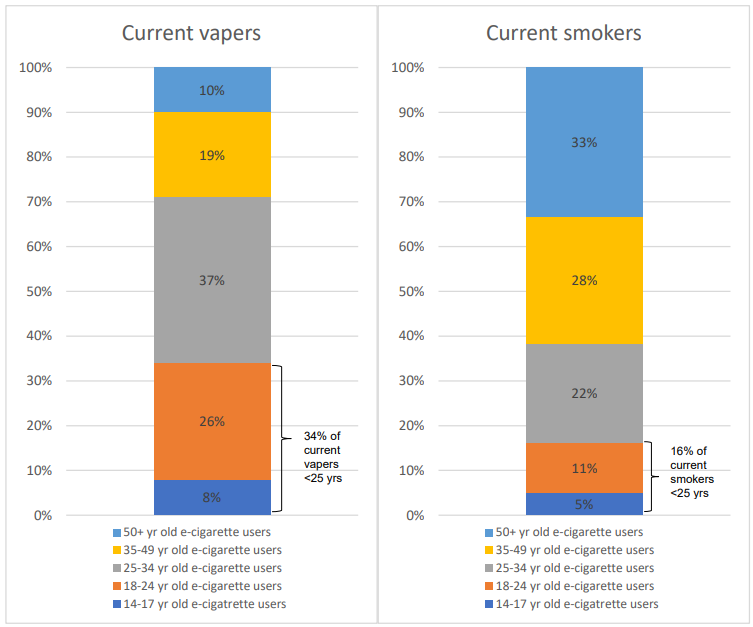On June 1, 2023, the Australian Department of Health and Aged Care released a survey report on trends in the prevalence of e-cigarettes and tobacco products among people aged 14 and over between February 2018 and March 2023, which showed a significant increase in the prevalence of e-cigarettes in the country from the second half of 2020.
This report may serve as the basis for the subsequent government to implement e-cigarette related policies, and this issue will introduce relevant data to you.
Population size and preference
Between January 2022 and March 2023, approximately 16.5% to 17.0% of the population aged 14 years and older used e-cigarettes and/or tobacco products;

b. Between 2018 and the first quarter of 2023, the proportion of e-cigarette users increased from 1.4% to 8.9%;

c. Between October 2022 and March 2023, the total population aged 14 years and older who used e-cigarettes and/or tobacco products was approximately 3.55 million, of which 49% were exclusive smokers, 31% were dedicated e-cigarette users, and 20% were dual users.

Population size and preferences by age group
The data broken down by the following 5 age groups are:
a. 14 to 17 years old, about 190,000, of which 9% are dedicated smokers, 29% are dedicated e-cigarette users, 62% are dual users;
b. 18 to 24 years old, about 540,000, of which 18% are dedicated smokers, 53% are dedicated e-cigarette users, 29% are dual users;
c. 25 to 34 years old, about 900,000, of which 30% are dedicated smokers, 43% are dedicated e-cigarette users, 27% are dual users;
d. 35~49 years old, about 890,000, of which 63% are dedicated smokers, 26% are dedicated e-cigarette users, 11% are dual users;
e. Age 50 and above, about 1.1 million, of which 80% are dedicated smokers, 10% are dedicated e-cigarette users, and 9% are dual users.
Proportion of e-cigarette users/smokers by age group
a. 14 to 17 years old, about 8% of e-cigarette users and about 5% of smokers;
b. 18~24 years old, about 26% of e-cigarette users, about 11% of smokers;
c. 25~34 years old, about 37% of e-cigarette users, about 22% of smokers;
d. 35~49 years old, about 19% of e-cigarette users, about 28% of smokers;
e. Age 50 and above, about 10% of e-cigarette users and about 33% of smokers.
Trends in e-cigarette prevalence
(a) Among 14-17 year olds, the prevalence increased substantially throughout 2021 and has since slowed, with this age group having the third highest prevalence of e-cigarettes by early 2023;
(b) Among 18-24 year olds, e-cigarette prevalence increases sharply from late 2020 to the end of 2022, with this age group having the highest e-cigarette prevalence in early 2023;
c. Among people aged 25-34, the prevalence of e-cigarettes has steadily increased since the second half of 2020. By early 2023, this age group will have the second highest prevalence of e-cigarettes;
Among people aged 35-49, the prevalence of e-cigarettes has steadily increased since the second half of 2020. By early 2023, this age group will have the second-lowest prevalence of e-cigarettes;
e. Among people over 50 years of age, except for a slight increase observed in early 2023, the prevalence of e-cigarettes in this age group remained relatively stable, with the lowest prevalence of e-cigarettes.

According to the current Australian e-cigarette policy, certain people should consume e-cigarette products with a prescription. The report may indicate that Australia's e-cigarette circulation channels have not been effectively controlled, and have not played the expected responsibility to help smokers quit and isolate minors, and it is recommended that relevant e-cigarette export enterprises pay attention to product quality and circulation compliance.
Strategy testing has professional e-cigarette compliance services and product testing capabilities to provide you with one-stop services for e-cigarette testing certification notification to help export to seize the market.


